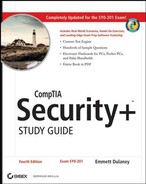1.7. Exam Essentials
Know the various aspects of information security.
Ensuring a secure network involves good design, implementation, and maintenance. The information in your organization is potentially vulnerable to both internal and external threats. Identify these threats and create methods of countering them before they happen.
Identify the potential physical, operational, and management policy decisions that affect your information security efforts.
It isn't good enough to have a plan if the plan is unsound or has gaping holes. You must make sure that the plans you develop and the procedures you follow to ensure security make sense for the organization and are effective in addressing the organization's needs.
Explain the relative advantages of the technologies available to you for authentication.
You have many tools available to establish authentication processes. Some of these tools start with a password and user ID. Others involve physical devices or the physical characteristics of the person who is requesting authentication. This area is referred to as I&A.
Be able to explain the relative capabilities of the technologies available to you for network security.
In most situations, you can create virtual LANs, create connections that are encrypted, and isolate high-risk assets from low-risk assets. You can do so using tunneling, DMZs, and network segmenting.
Identify and describe the goals of information security.
The three primary goals of information security are prevention, detection, and response. Your policies and systems must include these three aspects to be effective. Ideally, you want to prevent a security breach. If a breach happens, you should have methods to detect and respond to it as quickly as possible.
Be able to describe the processes and mechanisms that can be used to implement a secure environment.
Antivirus software, access control, and authentication are the three primary methods you have to implement a secure environment.
Identify the various access control methods used in systems and networks.
Three primary access control methods are used in computer systems today: MAC, DAC, and RBAC. The MAC method establishes all connections and relationships between users statically. The DAC method allows the user to have some control over what information and resources are accessible. The RBAC method sets access levels and permissions based on the role the user plays in a particular situation or job.
Know which services and protocols should be offered and which should not.
Many protocols and services in modern operating systems offer little if any security. These protocols and services may also be vulnerable to attack or offer no encryption in the logon process. Services that should be offered include only those that are necessary for legitimate business needs.
Be able to identify the three aspects of design goals of any security topology.
The design goals of a security topology must take into consideration the need for confidentiality, integrity, and availability. These three aspects are called the CIA of security topology. Additionally, you must consider issues of accountability. Who owns the data or is responsible for verifying that it is accurate?
Know the characteristics of the three types of commonly used security zones.
The three common security zones in place are the Internet, intranets, and extranets. The Internet offers low security. Intranets are considered high security, and extranets may be low to high security. Anytime you connect your network to another network, you increase the vulnerability of your network. One of the primary tools you can use to isolate less-secure resources from more-secure resources is a DMZ.
Be able to identify the differences and characteristics of the technologies available to you.
A network can be segmented, and VLANs can be created to improve security. NAT presents only one Internet address to the world, hiding the other elements of the network. Tunneling allows you to make relatively secure connections to other networks using the Internet.
Identify the four business requirements of a network security design.
Identifying assets, assessing risks, identifying threats, and evaluating vulnerabilities are the four primary business requirements that must be considered in a security design.
